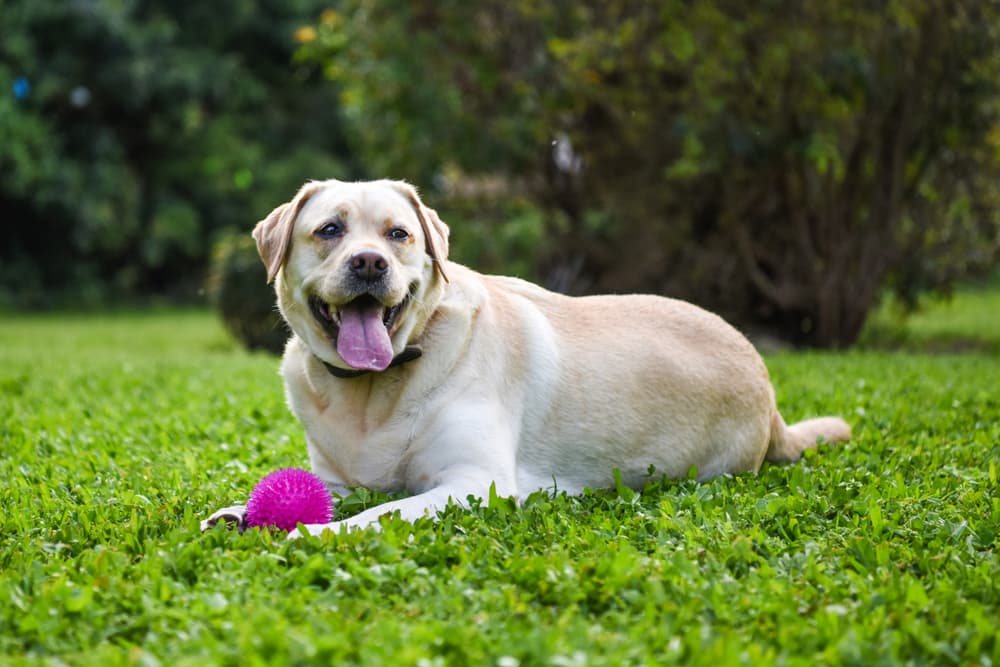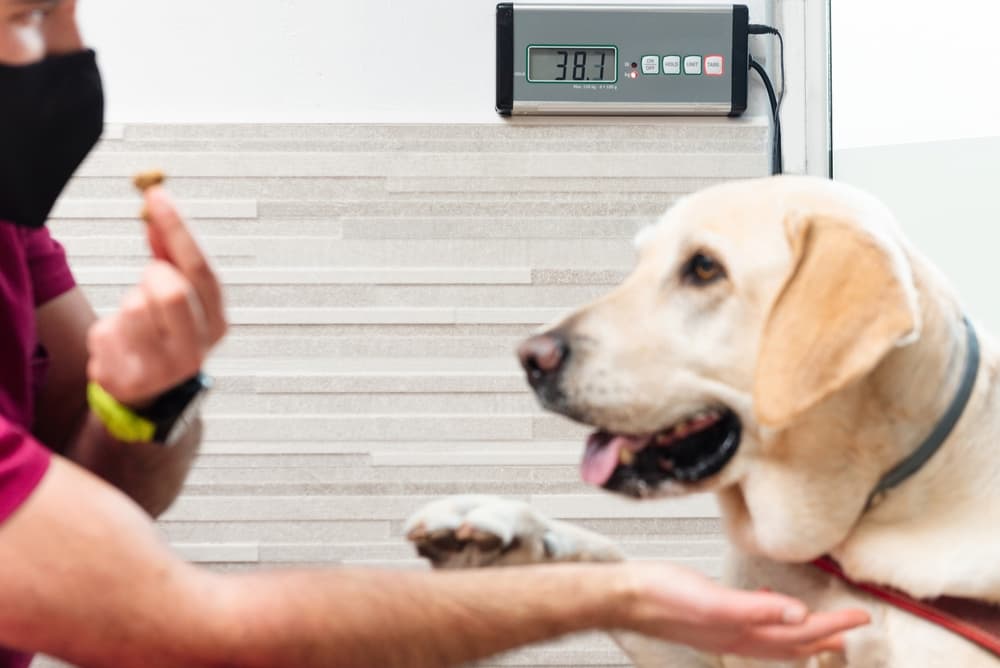Dog Obesity: Risks, Symptoms, and Weight Loss Solutions

Dog obesity is a growing concern in veterinary medicine. Nearly 60 percent of dogs are considered overweight or obese, according to a national survey done by the Association for Pet Obesity Prevention (1). Unfortunately, obesity has many negative health consequences that can affect a dog’s well-being and lifespan.
Pet parents play a vital role in helping their dogs maintain an ideal weight; in fact, 73 percent of dog owners surveyed in 2022 had implemented weight management strategies to help their pet shed some pounds (1).
Being knowledgeable about why obesity in dogs is a serious concern and learning how to address or prevent this condition can be extremely helpful for pet parents.
What is Dog Obesity?
Obesity refers to excessive weight gain in dogs that can negatively impact their ability to lead active, healthy lifestyles while also putting them at risk for several diseases. Obesity occurs when a dog’s body mass index is severely above the ideal range, which indicates obvious fat has been deposited throughout the body. According to the Morris Animal Foundation, overweight dogs are 10 percent to 30 percent above their ideal body weight, while obese dogs are at least 30 percent over their ideal weight [2]. This excess fat accumulation also increases inflammation throughout the body, which can be detrimental.
Causes of Obesity in Dogs

There are numerous causes for dog obesity, all of which may contribute to this condition alone or in combination. Underlying health conditions that can lead to weight gain in dogs, such as hypothyroidism or Cushing’s disease, should always be ruled out. Additionally, pet parents may unknowingly be overfeeding their dogs or offering too many treats. These extra calories can add up quickly in a dog’s diet. Likewise, if dogs do not get the appropriate amount of exercise each day, they fail to burn enough calories to maintain a healthy weight. As you can imagine, overfeeding plus little to no exercise is a problematic combination for many dogs.
Certain dog breeds are more likely to become overweight or obese. A recent study found that Golden Retrievers, Pugs, Beagles, English Springer Spaniels, and Border Terriers were at an increased risk of becoming overweight compared to other breeds [3]. Middle-aged or older dogs may also be more likely to gain weight not only because they tend to physically slow down as they age, but also because their metabolisms are slower. Spaying and neutering dogs may increase their risk of gaining weight, and there may be a genetic component that increases a dog’s risk for obesity as well.
Health Risks of Obesity in Dogs

Obese dogs are at an increased risk for serious health issues. Specific conditions that may arise more frequently in obese dogs include the following:
- Diabetes
- Heart disease
- Cancer
- Arthritis
- High blood pressure (hypertension)
- Respiratory disease
- Urinary tract diseases, such as bladder stones and infections
- Skin disorders
Additionally, obesity can shorten a dog’s overall lifespan and negatively impact his quality of life. If an underlying medical issue is present, obesity can make it difficult to manage concurrent diseases, which can be even more detrimental to the dog’s health.
Dog Obesity Symptoms

Obesity in dogs is easily detected by veterinarians due to its characteristic appearance. However, pet parents may overlook this condition. This is why annual checkups with the veterinarian are important in identifying any concerns that may be developing in pets.
Dogs who are obese will have a rotund appearance. When looking at them from above, there will be no clear hourglass shape as seen in dogs at a normal weight. When looking from the side, there will be obvious fat deposits over the shoulders, ribs, and hips. Additional signs of obesity in dogs include the following:
- Inability to feel or see the ribs through the skin
- Less energy
- Frequent or heavy panting
- Less willing to go for walks or play
Diagnosing Dog Obesity

Veterinarians diagnose obesity during a physical exam. The veterinarian will visually inspect the dog and then feel the ribs in order to assign a body condition score. Body condition is graded on either a scale of 1 to 9 or a scale of 1 to 5 depending on the veterinarian’s preference. Scores of 6 or above on the 9-point scale and 4 or above on the 5-point scale are considered overweight or obese. The higher the score, the more body fat is present, which directly correlates with obesity. A score of 9 would be considered grossly obese, for example.
Obese Dog Weight Loss Solutions
Veterinarians first address obesity in dogs by talking with pet parents about their dog’s history. This may include feeding and exercise routines and any pertinent medical history that may be contributing to the weight gain. Veterinarians may first do blood work or other testing to ensure there is not an underlying health condition causing the obesity. Once medical issues have been ruled out, veterinarians can work with pet parents to develop a weight management plan that will help their dogs lose weight.
First and foremost, reducing the number of treats and table scraps given each day by pet parents is essential. Likewise, measuring each meal and only feeding two distinct meals per day can aid in weight loss.
There are specific weight management dog foods that may be prescribed or recommended by the veterinarian as well, such as Hill’s Prescription Diet Metabolic Weight Management Dog Food (which requires a prescription to purchase) or Hill’s Science Diet Perfect Weight Dog Food (which does not).


Discover more veterinarian-approved weight management dog food options, along with the pros and cons of each formula, here.
And be sure to ask your veterinarian exactly how much food you should be serving up for your pup. Your vet can calculate the number of calories your dog needs per day in order to lose weight safely.
Increasing the amount of exercise each day, such as walking or playing fetch, can help dogs burn calories and return to a more ideal weight. Just be aware that dogs carrying extra weight are prone to arthritis, and vigorous activity while your dog is overweight could take a toll on your dog’s joints.
Some obese dogs may benefit from joint supplements containing chondroitin and glucosamine, such as Dasuquin Advanced or Cosequin, to help maintain joint health while they’re losing weight.



If your dog is showing signs of joint pain, ask your doctor if a pain medication, such as Galliprant or Carprofen, could help. Also, always consult with your vet first before you pursue any exercise plan with your pup, to make sure the exercises are safe for your dog and reduce the risk of injury.


Talking to Your Veterinarian About Dog Obesity
If you are worried about your dog’s weight, schedule an appointment with your veterinarian to discuss your concerns. It’s a good idea to prepare by gathering a list of questions ahead of time, so you can make sure you get the answers you need to help you manage your dog’s weight.
Here’s a helpful guide to make sure you have the most important questions covered.

How to Prevent Obesity in Dogs

Preventing obesity in dogs is easily done provided there are no underlying medical issues that the pet is dealing with. Simple steps pet parents can take to prevent their dogs from becoming obese include:
- Offer opportunities for regular, daily exercise
- Measure every meal
- Limit treats on a daily basis
- Feed a high-quality, nutritious diet
- Schedule regular veterinary checkups
By taking small steps each day, pet parents can ensure their dogs maintain an ideal weight. This will improve the dog’s overall quality of life and help keep them happy and healthy.
Dog Obesity Infographic

References
- “State of U.S. Pet Obesity.” Association for Pet Obesity Prevention. 2022. Retrieved from https://static1.squarespace.com/static/6425ec5d33eaaa634113b2d4/t/6454f61c0cad164860799c8f/1683289630779/2022+State+of+US+Pet+Obesity+Report.pdf
- “Understanding Obesity, Weight Loss in Dogs and Cats.” Morris Animal Foundation. Retrieved from https://www.morrisanimalfoundation.org/article/weight-loss-in-cats-and-dogs
- Pegram, C et al. “Frequency, breed predisposition and demographic risk factors for overweight status in dogs in the UK.” The Journal of small animal practice vol. 62,7 (2021): 521-530. doi:10.1111/jsap.13325









